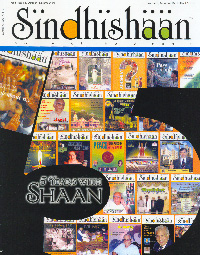The Inheritors of a Rare Kind
By Aruna Jethwani

Recently, I traveled to the interiors of Banni (Kutch), to experience Shah Latif’s Sindh. To live in ‘Bhongas’, to hear rare original Sufi Kalaams, to witness the unique feature of Sindhi poetry ‘Gujarat’, and to warble with “Wai” sung by jats, the camel riders, who in their black robes sing crescendos, pouring the wisdom of Shah Abdul Latif. In the process, I stumble upon the riches of Sindhi culture. It is a treasure mine, with the richness of language, synthesis of religion and beauty of spirituality of Sindhi language; its alliteration, its idioms, its symbols, and extensive repertoire of words with the same meaning is mind boggling. There are more than 20 words for camel and more than 9 words for water.
The vast spectrum of the language in itself is a matter of great pride. Wah, Wah! I am certainly proud to be the inheritor of the richest oxygenated language in the world! Perhaps few of us know, that the oldest musical instruments 'Bhorindo' and 'Chaang' originated in Sindh. The folk music to which 'Shah-jo-Rasaalo' is strummed to is comparable to the best in the world. Hear the musicians at Hodka outpost under the starlit moonless night, and you will know that the rap and the tap and harp are pale imitation of the Sindhi energy.
While it is true that ‘Rig Veda’ was written on the banks of Sindhu river; Rohiri and Sukkar were seats of legendary saints and ‘Manjhdan’ and ‘Halla’ durbars were riddled with miracles, the true spirituality lay in its Sufism, a spirituality of love without boundaries and barriers. A semblance of this I found in the oasis of Banni.
In a hamlet a Hindu saint Ram Dev Bapu has many Muslim devotees just as some Hindus worship at the local Durgah at the same place. The religion did not matter, so long you spoke the same language and had the same Sindhi soul.
All this makes me proud, but more than that it makes me wise. As a small child I lived with a philanthropic Gujarati family. The neighbours called us 'Nirvasi' - homeless. They treated us outcaste, because we were non-vegetarians, wore leather chappals at home and did not wash clothes every day. I used to feel miserable. Later the convent education and few Methodist classmates mocking at our gurus and religious icons made me feel ashamed of my Sindhiness. A Zoroastrian friend used to say if you meet a Sindhi and a snake, kill the Sindhi first. It is only when I moved to Bombay and Poona and mingled with the community that I realized that Sindhis are basically spiritual and philanthropists; they are homely and responsible. Sindhi men are clean and sincere, and Sindhi women no one can beat.
I still remember and cherish the spiritual glow on my mother's face-fair and beautiful, the positivism of faith written large, which helped the family to survive the partition; the open hearted hospitality, even when we were going through rough trough; the courage to face the impossible. "Sindhi woman is the soul of Sindh" often said Sadhu Vaswani, who glorified the spirit of Sindhi womanhood in many of his talks.
Today I can raise my head high and tell the world that being a Sindhi woman is a rare privilege, because we are the inheritors of a rare kind.


